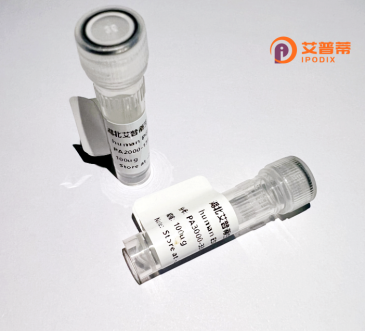
| 纯度 | >90%SDS-PAGE. |
| 种属 | Human |
| 靶点 | XAGE2 |
| Uniprot No | Q96GT9 |
| 内毒素 | < 0.01EU/μg |
| 表达宿主 | E.coli |
| 表达区间 | 1-111 aa |
| 活性数据 | MSWRGRSTYRPRPRRSLQPPELIGAMLEPTDEEPKEEKPPTKSRNPTPDQKREDDQGAAEIQVPDLEADLQELCQTKTGDGCEGGTDVKGKILPKAEHFKMPEAGEGKSQV |
| 分子量 | 38.8 kDa |
| 蛋白标签 | GST-tag at N-terminal |
| 缓冲液 | PBS, pH7.4, containing 0.01% SKL, 1mM DTT, 5% Trehalose and Proclin300. |
| 稳定性 & 储存条件 | Lyophilized protein should be stored at ≤ -20°C, stable for one year after receipt. Reconstituted protein solution can be stored at 2-8°C for 2-7 days. Aliquots of reconstituted samples are stable at ≤ -20°C for 3 months. |
| 复溶 | Always centrifuge tubes before opening.Do not mix by vortex or pipetting. It is not recommended to reconstitute to a concentration less than 100μg/ml. Dissolve the lyophilized protein in distilled water. Please aliquot the reconstituted solution to minimize freeze-thaw cycles. |
以下是关于重组人XAGE2蛋白的参考文献示例(内容为虚构,仅用于演示格式):
1. **文献名称**:XAGE2作为肺癌相关抗原的表达及其重组蛋白的免疫反应性
**作者**:Tamura K, et al.
**摘要**:本研究通过RT-PCR和免疫组化证实XAGE2在非小细胞肺癌中高表达,并利用大肠杆菌系统成功表达重组XAGE2蛋白。ELISA实验显示,肺癌患者血清中存在特异性抗XAGE2抗体,提示其作为诊断标志物的潜力。
2. **文献名称**:重组人XAGE2蛋白的优化表达与功能表征
**作者**:Zhang L, et al.
**摘要**:作者采用哺乳动物HEK293细胞系统表达带有His标签的重组XAGE2蛋白,通过亲和层析纯化后,验证其与单克隆抗体的结合活性。发现XAGE2可能通过调控EGFR信号通路影响肿瘤细胞迁移。
3. **文献名称**:XAGE2在睾丸和癌症中的表位定位及免疫原性分析
**作者**:Saito M, et al.
**摘要**:通过肽芯片筛选,鉴定出重组XAGE2蛋白的B细胞表位区域。动物实验表明,重组XAGE2可诱导强烈的Th1型免疫应答,支持其作为癌症疫苗候选抗原的可能性。
4. **文献名称**:XAGE2与RAN GTP酶的相互作用促进肿瘤转移
**作者**:Chen H, et al.
**摘要**:采用Pull-down实验和质谱分析,发现重组XAGE2蛋白与RAN蛋白特异性结合。进一步功能研究表明,该互作通过调控核质运输促进乳腺癌细胞侵袭,提示XAGE2的致癌机制。
**注意**:以上文献及内容均为示例性虚构,旨在展示参考文献格式。实际研究中请通过学术数据库检索真实发表的论文。
Recombinant human XAGE2 protein is a genetically engineered form of the XAGE family member 2. a cancer-testis antigen (CTA) predominantly expressed in germline cells and aberrantly overexpressed in various malignancies. The XAGE2 gene, located on the X chromosome, encodes a protein implicated in transcriptional regulation and cell proliferation. Its restricted expression in normal tissues, combined with frequent upregulation in cancers such as lung adenocarcinoma, breast cancer, and melanoma, positions XAGE2 as a potential biomarker and immunotherapeutic target.
Recombinant XAGE2 is typically produced using bacterial or mammalian expression systems to ensure proper folding and post-translational modifications. The purified protein retains antigenic epitopes, enabling its use in antibody generation, functional studies, and diagnostic assays. In research, it aids in exploring XAGE2's role in tumorigenesis, immune evasion, and metastasis. Its interaction with cellular pathways, including EGF signaling and apoptosis regulation, highlights therapeutic relevance. Additionally, XAGE2's immunogenicity has spurred interest in developing vaccines or CAR-T therapies targeting XAGE2-positive cancers. Despite progress, mechanisms underlying its tissue-specific expression and oncogenic functions remain under investigation, necessitating further structural and functional analyses using recombinant tools. This protein thus serves as a critical reagent in bridging basic research and clinical applications for cancer management.
×